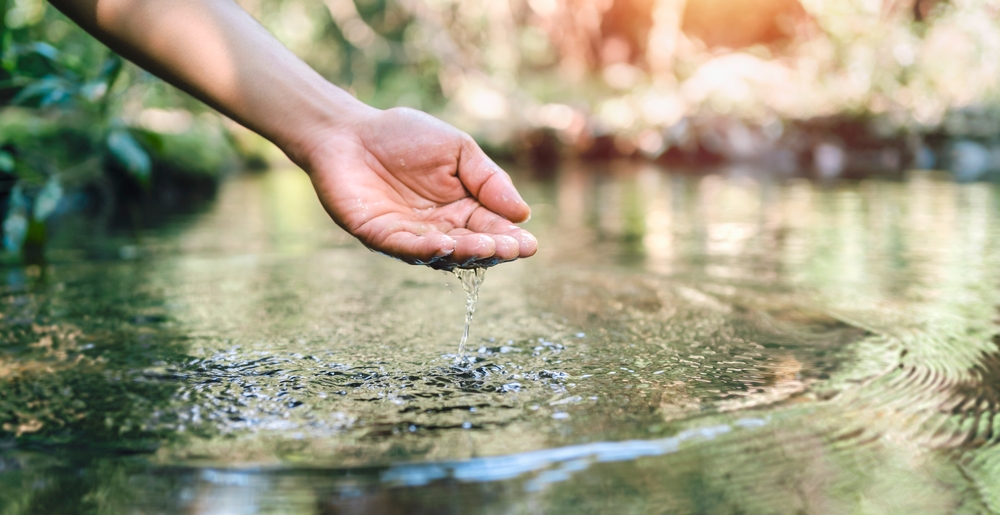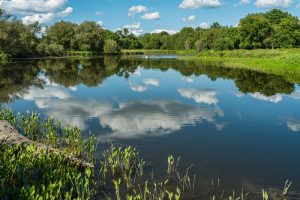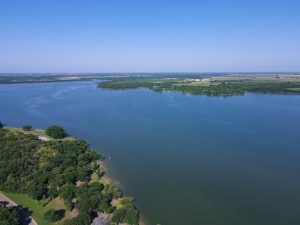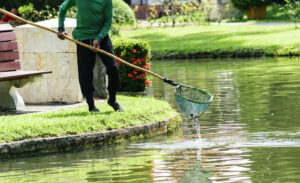Maintaining a healthy and attractive pond requires regular upkeep and attention. Whether you have a small backyard pond or a large commercial stormwater pond, there are several best practices that can help ensure its longevity and beauty. Our management professionals are here to provide you with the pond maintenance best practices you need this season.
Ensure your pond remains healthy for years to come by keeping these four pond maintenance best practices. Share on X
What pond maintenance best practices should you be implementing?
From managing water quality to controlling algae growth, these practices are essential for creating a thriving aquatic ecosystem. In this article, we’ll explore four pond maintenance best practices that every pond owner should be aware of to keep their pond in optimal condition.
- Keep Beneficial Pond Plants
- Trim Back Excessive Foliage
- Consider Aeration
- Sign Up For a Maintenance Plan
1) Keep Beneficial Pond Plants
One of the most effective ways to maintain a healthy pond ecosystem is to keep beneficial pond plants. These plants not only add beauty to the pond but also help to oxygenate the water, absorb excess nutrients, and provide shelter for fish and other aquatic animals. Examples of beneficial pond plants include water lilies, duckweed, and water hyacinths.
2) Trim Back Excessive Foliage
Excessive foliage, such as leaves and dead plant material, can accumulate in the pond and lead to poor water quality. Regularly trimming back excessive foliage can help to prevent this buildup and maintain a healthy pond ecosystem. Additionally, pruning back overgrown plants can help to prevent the pond from becoming overcrowded and ensure that there is enough space for all aquatic life.
Pro Tip: Do you have excessive weeds or algae? Waterline specializes in cleaning pond systems of all sizes. Our equipment is designed to get into areas often out of reach and thoroughly remove weeds at their root. Now only does this keep your ponds clean more efficiently, but will prevent further foliage buildup in the future.
3) Consider Aeration
Aeration is the process of adding oxygen to the water in a pond, and it is crucial for maintaining a healthy aquatic ecosystem. Installing an aeration system, such as a fountain or waterfall, can help to prevent the buildup of harmful gases in the water and promote healthy bacterial growth. Aeration can also help to prevent algae growth and improve the overall water quality of the pond.
4) Sign Up For a Maintenance Plan
For those who may not have the time or expertise to properly maintain their pond, signing up for a maintenance plan with a professional pond maintenance company can be a great option. These plans typically include regular cleaning, water testing, and other necessary services to keep the pond in optimal condition. With a maintenance plan, pond owners can ensure that their pond remains healthy and attractive year-round without the stress of doing it themselves.
Importance of Ongoing Pond Maintenance
Ongoing pond maintenance is crucial for several reasons:
- Water Quality: Regular pond maintenance is necessary to ensure that the water quality is healthy for the pond’s inhabitants, such as fish and plants. If the water quality is poor, it can lead to the growth of harmful algae and bacteria, which can be harmful to the ecosystem.
- Aesthetics: A well-maintained pond is visually appealing and can enhance the beauty of your landscape. Regular maintenance will help keep the pond free from debris, algae, and other unsightly growths.
- Functionality: If a pond is not properly maintained, it can lead to problems such as clogged pumps, leaks, and other issues that can affect the pond’s functionality. Regular maintenance can help prevent these problems and ensure that the pond is working as it should.
- Cost Savings: Neglecting pond maintenance can lead to costly repairs down the road. Regular maintenance can help identify and address issues early on, which can prevent them from becoming more expensive problems in the future.
Let Waterline Help
Maintaining a healthy and attractive pond is essential for creating a thriving aquatic ecosystem that benefits both the plants and animals living within it. By implementing the four pond maintenance best practices outlined in this article, pond owners can ensure that their pond remains healthy and beautiful for years to come.
Whether it’s keeping beneficial pond plants, trimming back excessive foliage, considering aeration, or signing up for a maintenance plan, each practice plays a crucial role in maintaining the pond’s ecosystem. With regular care and attention, pond owners can enjoy a stunning outdoor oasis that they can be proud of.
Contact us to schedule your next pond cleaning appointment.



